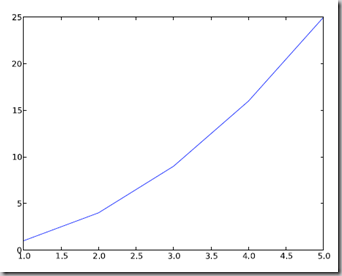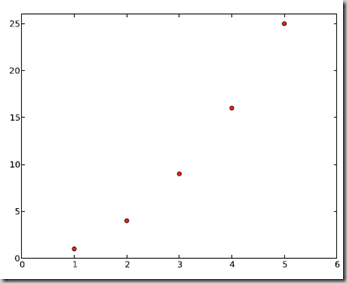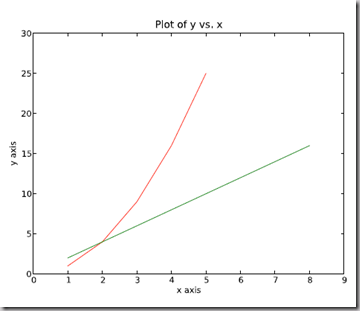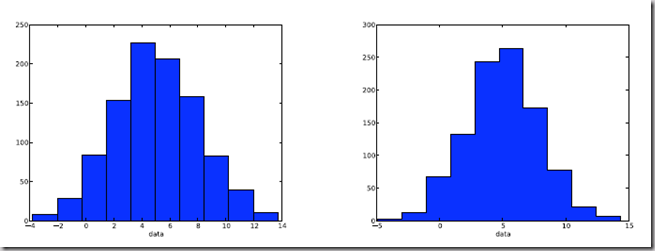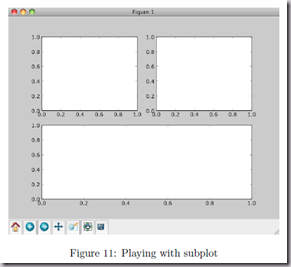http://blog.csdn.net/pipisorry/article/details/40005163
Matplotlib.pyplot画图实例
{使用pyplot模块}
matplotlib绘制直线、条形/矩形区域
import numpy as np import matplotlib.pyplot as plt t = np.arange(-1, 2, .01) s = np.sin(2 * np.pi * t) plt.plot(t,s) # draw a thick red hline at y=0 that spans the xrange l = plt.axhline(linewidth=4, color='r') plt.axis([-1, 2, -1, 2]) plt.show() plt.close() # draw a default hline at y=1 that spans the xrange plt.plot(t,s) l = plt.axhline(y=1, color='b') plt.axis([-1, 2, -1, 2]) plt.show() plt.close() # draw a thick blue vline at x=0 that spans the upper quadrant of the yrange plt.plot(t,s) l = plt.axvline(x=0, ymin=0, linewidth=4, color='b') plt.axis([-1, 2, -1, 2]) plt.show() plt.close() # draw a default hline at y=.5 that spans the the middle half of the axes plt.plot(t,s) l = plt.axhline(y=.5, xmin=0.25, xmax=0.75) plt.axis([-1, 2, -1, 2]) plt.show() plt.close() plt.plot(t,s) p = plt.axhspan(0.25, 0.75, facecolor='0.5', alpha=0.5) p = plt.axvspan(1.25, 1.55, facecolor='g', alpha=0.5) plt.axis([-1, 2, -1, 2]) plt.show()效果图展示
Note: 设置直线相应位置的值显示:plt.text(max_x, 0, str(round(max_x, 2)))。也就是直接在指定坐标写文字。不知道有没有其他方法?
另一种绘制直线的方式
plt.hlines(hline, xmin=plt.gca().get_xlim()[0], xmax=plt.gca().get_xlim()[1], linestyles=line_style, colors=color)
直方图
plt.hist(songs_plays, bins=50,range=(0, 50000), color='lightblue',normed=True)
Note: normed是将y坐标按比例画图,而不是数目。
hist转换成plot折线图
plt.hist直接绘制数据是hist图
plt.hist(z, bins=500, normed=True)hist图转换成折线图
cnts, bins = np.histogram(z, bins=500, normed=True) bins = (bins[:-1] + bins[1:]) / 2 plt.plot(bins, cnts)[numpy教程 - 统计函数:histogram]
散点图、梯形图、柱状图、填充图
散列图scatter()
使用plot()画图时。假设指定样式參数为仅绘制数据点,那么所绘制的就是一幅散列图。可是这样的方法所绘制的点无法单独指定颜色和大小。
scatter()所绘制的散列图却能够指定每一个点的颜色和大小。
scatter()的前两个參数是数组,分别指定每一个点的X轴和Y轴的坐标。
s參数指定点的大 小。值和点的面积成正比。它能够是一个数,指定全部点的大小;也能够是数组。分别对每一个点指定大小。
c參数指定每一个点的颜色。能够是数值或数组。这里使用一维数组为每一个点指定了一个数值。
通过颜色映射表,每一个数值都会与一个颜色相相应。
默认的颜色映射表中蓝色与最小值相应,红色与最大值相应。当c參数是形状为(N,3)或(N,4)的二维数组时。则直接表示每一个点的RGB颜色。
marker參数设置点的形状,能够是个表示形状的字符串,也能够是表示多边形的两个元素的元组。第一个元素表示多边形的边数。第二个元素表示多边形的样式,取值范围为0、1、2、3。0表示多边形,1表示星形,2表示放射形。3表示忽略边数而显示为圆形。
alpha參数设置点的透明度。
lw參数设置线宽,lw是line width的缩写。
facecolors參数为“none”时,表示散列点没有填充色。
柱状图bar()
用每根柱子的长度表示值的大小,它们通经常使用来比較两组或多组值。
bar()的第一个參数为每根柱子左边缘的横坐标;第二个參数为每根柱子的高度;第三个參数指定全部柱子的宽度,当第三个參数为序列时,能够为每根柱子指定宽度。bar()不自己主动改动颜色。
n = np.array([0,1,2,3,4,5]) x = np.linspace(-0.75, 1., 100) fig, axes = plt.subplots(1, 4, figsize=(12,3)) axes[0].scatter(x, x + 0.25*np.random.randn(len(x))) axes[1].step(n, n**2, lw=2) axes[2].bar(n, n**2, align="center", width=0.5, alpha=0.5) axes[3].fill_between(x, x**2, x**3, color="green", alpha=0.5);

Note: axes子图设置title: axes.set_title("bar plot")
散点图(改变颜色,大小)
import numpy as np import matplotlib.pyplot as plt
N = 50
x = np.random.rand(N)
y = np.random.rand(N)
area = np.pi * (15 * np.random.rand(N))**2 # 0 to 15 point radiuses
color = 2 * np.pi * np.random.rand(N)
plt.scatter(x, y, s=area, c=color, alpha=0.5, cmap=plt.cm.hsv)
plt.show()

matplotlib绘制散点图给点加上凝视
plt.scatter(data_arr[:, 0], data_arr[:, 1], c=class_labels)
for i, class_label in enumerate(class_labels):
plt.annotate(class_label, (data_arr[:, 0][i], data_arr[:, 1][i]))[matplotlib scatter plot with different text at each data point]对数坐标图
plot()所绘制图表的X-Y轴坐标都是算术坐标。
绘制对数坐标图的函数有三个:semilogx()、semilogy()和loglog(),它们分别绘制X轴为对数坐标、Y轴为对数坐标以及两个轴都为对数坐标时的图表。
以下的程序使用4种不同的坐标系绘制低通滤波器的频率响应曲线。
当中,左上图为plot()绘制的算术坐标系。右上图为semilogx()绘制的X轴对数坐标系,左下图 为semilogy()绘制的Y轴对数坐标系。右下图为loglog()绘制的双对数坐标系。使用双对数坐标系表示的频率响应曲线通常被称为波特图。
import numpy as np
import matplotlib.pyplot as plt
w = np.linspace(0.1, 1000, 1000)
p = np.abs(1/(1+0.1j*w)) # 计算低通滤波器的频率响应
plt.subplot(221)
plt.plot(w, p, linewidth=2)
plt.ylim(0,1.5)
plt.subplot(222)
plt.semilogx(w, p, linewidth=2)
plt.ylim(0,1.5)
plt.subplot(223)
plt.semilogy(w, p, linewidth=2)
plt.ylim(0,1.5)
plt.subplot(224)
plt.loglog(w, p, linewidth=2)
plt.ylim(0,1.5)
plt.show()
极坐标图
极坐标系是和笛卡尔(X-Y)坐标系全然不同的坐标系,极坐标系中的点由一个夹角和一段相对中心点的距离来表示。polar(theta, r, **kwargs)
能够polar()直接创建极坐标子图并在当中绘制曲线。也能够使用程序中调用subplot()创建子图时通过设 polar參数为True,创建一个极坐标子图,然后调用plot()在极坐标子图中画图。
演示样例1
fig = plt.figure()
ax = fig.add_axes([0.0, 0.0, .6, .6], polar=True)
t = linspace(0, 2 * pi, 100)
ax.plot(t, t, color='blue', lw=3);
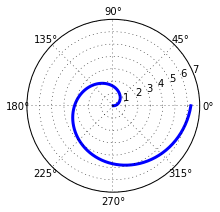
演示样例2
import numpy as np
import matplotlib.pyplot as plt
theta = np.arange(0, 2*np.pi, 0.02)
plt.subplot(121, polar=True)
plt.plot(theta, 1.6*np.ones_like(theta), linewidth=2) #绘制同心圆
plt.plot(3*theta, theta/3, "--", linewidth=2)
plt.subplot(122, polar=True)
plt.plot(theta, 1.4*np.cos(5*theta), "--", linewidth=2)
plt.plot(theta, 1.8*np.cos(4*theta), linewidth=2)
plt.rgrids(np.arange(0.5, 2, 0.5), angle=45)
plt.thetagrids([0, 45])
plt.show()
Note:rgrids()设置同心圆栅格的半径大小和文字标注的角度。因此右图中的虚线圆圈有三个。 半径分别为0.5、1.0和1.5,这些文字沿着45°线排列。
Thetagrids()设置放射线栅格的角度, 因此右图中仅仅有两条放射线,角度分别为0°和45°。
[matplotlib.pyplot.polar(*args, **kwargs)]
等值线图
使用等值线图表示二元函数z=f(x,y)
所谓等值线,是指由函数值相等的各点连成的平滑曲线。等值线能够直观地表示二元函数值的变化趋势,比如等值线密集的地方表示函数值在此处的变化较大。
matplotlib中能够使用contour()和contourf()描绘等值线,它们的差别是:contourf()所得到的是带填充效果的等值线。
import numpy as np
import matplotlib.pyplot as plt
y, x = np.ogrid[-2:2:200j, -3:3:300j]
z = x * np.exp( - x**2 - y**2)
extent = [np.min(x), np.max(x), np.min(y), np.max(y)]
plt.figure(figsize=(10,4))
plt.subplot(121)
cs = plt.contour(z, 10, extent=extent)
plt.clabel(cs)
plt.subplot(122)
plt.contourf(x.reshape(-1), y.reshape(-1), z, 20)
plt.show()
为了更淸楚地区分X轴和Y轴。这里让它们的取值范围和等分次数均不相同.这样得 到的数组z的形状为(200, 300),它的第0轴相应Y轴、第1轴相应X轴。
调用contour()绘制数组z的等值线图,第二个參数为10,表示将整个函数的取值范围等分为10个区间,即显示的等值线图中将有9条等值线。能够使用extent參数指定等值线图的X轴和Y轴的数据范围。
contour()所返回的是一个QuadContourSet对象, 将它传递给clabel(),为当中的等值线标上相应的值。
调用contourf(),绘制将取值范围等分为20份、带填充效果的等值线图。
这里演示了第二种设置X、Y轴取值范围的方法,它的前两个參数各自是计算数组z时所使用的X轴和Y轴上的取样点,这两个数组必须是一维的。
使用等值线绘制隐函数f(x,y)=0曲线
显然,无法像绘制一般函数那样,先创建一个等差数组表示变量的取值点。然后计算出数组中每一个x所相应的y值。
能够使用等值线解决问题,显然隐函数的曲线就是值等于0的那条等值线。
程序绘制函数在f(x,y)=0和 f(x,y)-0.1 = 0时的曲线。
import numpy as np
import matplotlib.pyplot as plt
y, x = np.ogrid[-1.5:1.5:200j, -1.5:1.5:200j]
f = (x**2 + y**2)**4 - (x**2 - y**2)**2
plt.figure(figsize=(9,4))
plt.subplot(121)
extent = [np.min(x), np.max(x), np.min(y), np.max(y)]
cs = plt.contour(f, extent=extent, levels=[0, 0.1], colors=["b", "r"], linestyles=["solid", "dashed"], linewidths=[2, 2])
plt.subplot(122)
for c in cs.collections:
data = c.get_paths()[0].vertices
plt.plot(data[:,0], data[:,1], color=c.get_color()[0], linewidth=c.get_linewidth()[0])
plt.show()
contour() levels參数指定所绘制等值线相应的函数值。这里设置levels參数为[0,0.1],因此终于将绘制两条等值线。
观察图会发现。表示隐函数f(x)=0蓝色实线并非全然连续的。在图的中间部分它由很多孤立的小段构成。
由于等值线在原点附近无限靠近,因此不管对函数f的取值空间怎样进行细分,总是会有无法分开的地方。终于造成了图中的那些孤立的细小区域。
而表示隐函数f(x,y)=0的红色虚线则是闭合且连续的。
contour()返回对象QuadContourSet
能够通过contour()返回对象获得等值线上每点的数据。以下我们在IPython中观察变量cs,它是一个 QuadContourSet 对象:
cs对象的collections属性是一个等值线列表,每条等值线用一个LineCollection对象表示:
>>> cs.collections
<a list of 2 collections.LineCollection objects>
每一个LineCollection对象都有它自己的颜色、线型、线宽等属性,注意这些属性所获得的结果外面另一层封装,要获得其第0个元素才是真正的配置:
>>> c0.get_color()[0]
array([ 0., 0., 1., 1.])
>>> c0.get_linewidth()[0]
2
由类名可知,LineCollection对象是一组曲线的集合。因此它能够表示像蓝色实线那样由多条线构成的等值线。它的get_paths()方法获得构成等值线的全部路径,本例中蓝色实线
所表示的等值线由42条路径构成:
>>> len(cs.collections[0].get_paths())
42
路径是一个Path对象,通过它的vertices属性能够获得路径上全部点的坐标:
>>> path = cs.collections[0].get_paths()[0]
>>> type(path)
<class 'matplotlib.path.Path'>
>>> path.vertices
array([[-0.08291457, -0.98938936],
[-0.09039269, -0.98743719],
…,
[-0.08291457, -0.98938936]])
上面的程序plt.subplot(122)就是从等值线集合cs中找到表示等值线的路径,并使用plot()将其绘制出来。
Matplotlib.pylab画图实例
{使用pylab模块}
matplotlib还提供了一个名为pylab的模块,当中包含了很多NumPy和pyplot模块中经常使用的函数,方便用户高速进行计算和画图,十分适合在IPython交互式环境中使用。这里使用以下的方式加载pylab模块:
>>> import pylab as plNote:import pyplot as plt也相同能够
两种经常使用图类型
Line and scatter plots(使用plot()命令), histogram(使用hist()命令)
1 折线图&散点图 Line and scatter plots
折线图 Line plots(关联一组x和y值的直线)
import numpy as np
import pylab as pl
x = [1, 2, 3, 4, 5]# Make an array of x values
y = [1, 4, 9, 16, 25]# Make an array of y values for each x value
pl.plot(x, y)# use pylab to plot x and y
pl.show()# show the plot on the screen
plot(x, y) # plot x and y using default line style and color plot(x, y, 'bo') # plot x and y using blue circle markers plot(y) # plot y using x as index array 0..N-1 plot(y, 'r+') # ditto, but with red plusses
plt.plot(ks, wssses, marker='*', markerfacecolor='r', linestyle='-', color='b')
散点图 Scatter plots
把pl.plot(x, y)改成pl.plot(x, y, 'o')
美化 Making things look pretty
线条颜色 Changing the line color
红色:把pl.plot(x, y, 'o')改成pl.plot(x, y, ’or’)
线条样式 Changing the line style
虚线:plot(x,y, '--')
marker样式 Changing the marker style
蓝色星型markers:plot(x,y, ’b*’)
详细见附录 - matplotlib中的作图參数
图和轴标题以及轴坐标限度 Plot and axis titles and limits
import numpy as np
import pylab as pl
x = [1, 2, 3, 4, 5]# Make an array of x values
y = [1, 4, 9, 16, 25]# Make an array of y values for each x value
pl.plot(x, y)# use pylab to plot x and y
pl.title(’Plot of y vs. x’)# give plot a title
pl.xlabel(’x axis’)# make axis labels
pl.ylabel(’y axis’)
pl.xlim(0.0, 7.0)# set axis limits
pl.ylim(0.0, 30.)
pl.show()# show the plot on the screen
一个坐标系上绘制多个图 Plotting more than one plot on the same set of axes
依次作图就可以
import numpy as np
import pylab as pl
x1 = [1, 2, 3, 4, 5]# Make x, y arrays for each graph
y1 = [1, 4, 9, 16, 25]
x2 = [1, 2, 4, 6, 8]
y2 = [2, 4, 8, 12, 16]
pl.plot(x1, y1, ’r’)# use pylab to plot x and y
pl.plot(x2, y2, ’g’)
pl.title(’Plot of y vs. x’)# give plot a title
pl.xlabel(’x axis’)# make axis labels
pl.ylabel(’y axis’)
pl.xlim(0.0, 9.0)# set axis limits
pl.ylim(0.0, 30.)
pl.show()# show the plot on the screen
图例 Figure legends
pl.legend((plot1, plot2), (’label1, label2’),loc='best’, numpoints=1)
第三个參数loc=表示图例放置的位置:'best’‘upper right’, ‘upper left’, ‘center’, ‘lower left’, ‘lower right’.
假设在当前figure里plot的时候已经指定了label,如plt.plot(x,z,label="
import numpy as np
import pylab as pl
x1 = [1, 2, 3, 4, 5]# Make x, y arrays for each graph
y1 = [1, 4, 9, 16, 25]
x2 = [1, 2, 4, 6, 8]
y2 = [2, 4, 8, 12, 16]
plot1 = pl.plot(x1, y1, ’r’)# use pylab to plot x and y : Give your plots names
plot2 = pl.plot(x2, y2, ’go’)
pl.title(’Plot of y vs. x’)# give plot a title
pl.xlabel(’x axis’)# make axis labels
pl.ylabel(’y axis’)
pl.xlim(0.0, 9.0)# set axis limits
pl.ylim(0.0, 30.)
pl.legend([plot1, plot2], (’red line’, ’green circles’), ’best’, numpoints=1)# make legend
pl.show()# show the plot on the screen
2 直方图 Histograms
import numpy as np
import pylab as pl
# make an array of random numbers with a gaussian distribution with
# mean = 5.0
# rms = 3.0
# number of points = 1000
data = np.random.normal(5.0, 3.0, 1000)
# make a histogram of the data array
pl.hist(data)
# make plot labels
pl.xlabel(’data’)
pl.show()
假设不想要黑色轮廓能够改为pl.hist(data, histtype=’stepfilled’)
自己定义直方图bin宽度 Setting the width of the histogram bins manually
添加两行
bins = np.arange(-5., 16., 1.) #浮点数版本号的range
pl.hist(data, bins, histtype=’stepfilled’)
同一画板上绘制多幅子图 Plotting more than one axis per canvas
假设须要同一时候绘制多幅图表的话,能够是给figure传递一个整数參数指定图标的序号。假设所指定
序号的画图对象已经存在的话。将不创建新的对象,而仅仅是让它成为当前画图对象。
fig1 = pl.figure(1)
pl.subplot(211)
subplot(211)把画图区域等分为2行*1列共两个区域, 然后在区域1(上区域)中创建一个轴对象. pl.subplot(212)在区域2(下区域)创建一个轴对象。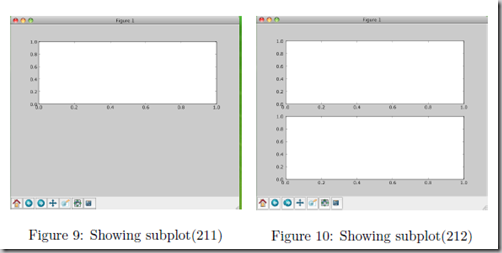
You can play around with plotting a variety of layouts. For example, Fig. 11 is created using the following commands:
f1 = pl.figure(1)
pl.subplot(221)
pl.subplot(222)
pl.subplot(212)
当画图对象中有多个轴的时候,能够通过工具栏中的Configure Subplotsbutton,交互式地调节轴之间的间距和轴与边框之间的距离。
假设希望在程序中调节的话,能够调用subplots_adjust函数。它有left, right, bottom, top, wspace, hspace等几个keyword參数,这些參数的值都是0到1之间的小数。它们是以画图区域的宽高为1进行正规化之后的坐标或者长度。
pl.subplots_adjust(left=0.08, right=0.95, wspace=0.25, hspace=0.45)
绘制圆形Circle和椭圆Ellipse
1. 调用包函数
###################################
# coding=utf-8
# !/usr/bin/env python
# __author__ = 'pipi'
# ctime 2014.10.11
# 绘制椭圆和圆形
###################################
from matplotlib.patches import Ellipse, Circle
import matplotlib.pyplot as plt
fig = plt.figure()
ax = fig.add_subplot(111)
ell1 = Ellipse(xy = (0.0, 0.0), width = 4, height = 8, angle = 30.0, facecolor= 'yellow', alpha=0.3)
cir1 = Circle(xy = (0.0, 0.0), radius=2, alpha=0.5)
ax.add_patch(ell1)
ax.add_patch(cir1)
x, y = 0, 0
ax.plot(x, y, 'ro')
plt.axis('scaled')
# ax.set_xlim(-4, 4)
# ax.set_ylim(-4, 4)
plt.axis('equal') #changes limits of x or y axis so that equal increments of x and y have the same length
plt.show()
參见Matplotlib.pdf Release 1.3.1文档
p187
18.7 Ellipses (see arc)
p631class matplotlib.patches.Ellipse(xy, width, height, angle=0.0, **kwargs)Bases: matplotlib.patches.PatchA scale-free ellipse.xy center of ellipsewidth total length (diameter) of horizontal axisheight total length (diameter) of vertical axisangle rotation in degrees (anti-clockwise)p626class matplotlib.patches.Circle(xy, radius=5, **kwargs)
或者參见Matplotlib.pdf Release 1.3.1文档contour绘制圆
#coding=utf-8
import numpy as np
import matplotlib.pyplot as plt
x = y = np.arange(-4, 4, 0.1)
x, y = np.meshgrid(x,y)
plt.contour(x, y, x**2 + y**2, [9]) #x**2 + y**2 = 9 的圆形
plt.axis('scaled')
plt.show()p478Axes3D.contour(X, Y, Z, *args, **kwargs)
Create a 3D contour plot.
Argument Description
X, Y, Data values as numpy.arrays
Z
extend3d
stride
zdir
offset
Whether to extend contour in 3D (default: False)
Stride (step size) for extending contour
The direction to use: x, y or z (default)
If specified plot a projection of the contour lines on this position in plane normal to zdir
The positional and other
p1025
matplotlib.pyplot.axis(*v, **kwargs)
Convenience method to get or set axis properties.
或者參见demo【pylab_examples example code: ellipse_demo.py】
2. 直接绘制
#coding=utf-8
'''
Created on Jul 14, 2014
@author: pipi
'''
from math import pi
from numpy import cos, sin
from matplotlib import pyplot as plt
if __name__ == '__main__':
'''plot data margin'''
angles_circle = [i*pi/180 for i in range(0,360)] #i先转换成double
#angles_circle = [i/np.pi for i in np.arange(0,360)] # <=>
# angles_circle = [i/180*pi for i in np.arange(0,360)] X
x = cos(angles_circle)
y = sin(angles_circle)
plt.plot(x, y, 'r')
plt.axis('equal')
plt.axis('scaled')
plt.show()[http://www.zhihu.com/question/25273956/answer/30466961?
group_id=897309766#comment-61590570]
画图小技巧
控制坐标轴的显示——使x轴显示名称字符串而不是数字的两种方法
plt.xticks(range(len(list)), x, rotation='vertical')
Note:x代表一个字符串列表,如x轴上要显示的名称。
axes.set_xticklabels(x, rotation='horizontal', lod=True)
Note:这里axes是plot的一个subplot()
获取x轴上坐标最小最大值
xmin, xmax = plt.gca().get_xlim()
在指定坐标写文字
plt.text(max_x, 0, str(round(max_x, 2)))
其他进阶[matplotlib画图进阶]
from:http://blog.csdn.net/pipisorry/article/details/40005163
ref:matplotlib Plotting commands summary*
Gallery:Click on any image to see full size image and source code
用Python做科学计算-基础篇——matplotlib-绘制精美的图表
matplotlib画图手冊 /subplot
matplotlib - 2D and 3D plotting in Python
matplotlib画图库入门绘制精美的图表
使用 python Matplotlib 库画图
barChart:http://www.cnblogs.com/qianlifeng/archive/2012/02/13/2350086.html
matplotlib--python绘制图表 | PIL--python图像处理
魔法(Magic)命令%magic -%matplotlibinline
Gnuplot的介绍
IBM:基于 Python Matplotlib 模块的高质量图形输出(2005年的文章有点旧)matplotlib技巧集(绘制不连续函数的不连续点;參数曲线上绘制方向箭头;改动缺省刻度数目。Y轴不同区间使用不同颜色填充的曲线区域。
)
Python:使用matp绘制不连续函数的不连续点。參数曲线上绘制方向箭头。改动缺省刻度数目;Y轴不同区间使用不同颜色填充的曲线区域。
lotlib绘制图表






